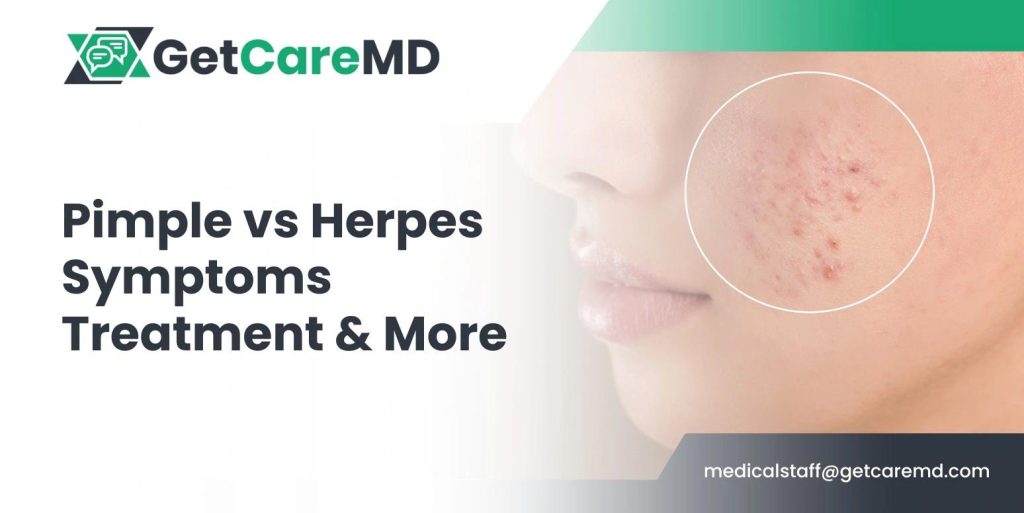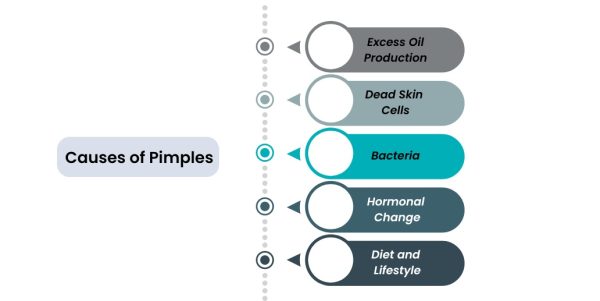When it comes to skin health, knowing the difference between a pimple and herpes is crucial. While both can cause discomfort and affect your appearance, the underlying causes and treatments are vastly different. Misunderstanding these conditions can lead to ineffective treatment and prolonged suffering.
Understanding the signs, symptoms, and distinctions can empower you to take the right steps toward healing and prevention. Let’s explore the world of skin health to ensure you’re equipped with the knowledge to tackle these issues head-on.
What Does Herpes Look Like?
Herpes is a viral infection caused by the herpes simplex virus (HSV). It often manifests as clusters of small, painful blisters on the skin. These blisters can appear on various parts of the body, including the mouth, face, and genitals. The blisters are typically filled with clear or yellowish fluid and eventually burst, leaving behind small sores that crust over and heal within a few weeks.
Symptoms
The symptoms of herpes can vary depending on the type of HSV. Here are the common signs to watch for:
- Initial Tingling or Itching: Before the blisters appear, you might feel a tingling, itching, or burning sensation in the affected area.
- Blisters: Small, painful blisters filled with fluid are the hallmarks of a herpes outbreak. These can be singular or form clusters.
- Ulcers: After the blisters burst, they leave behind shallow, painful ulcers that take time to heal.
- Swollen Lymph Nodes: You might experience swelling in the lymph nodes near the affected area.
- Fever and Malaise: During an initial outbreak, some individuals may experience flu-like symptoms, including fever, body aches, and general discomfort.
Causes of Herpes
Herpes is caused by two types of viruses: HSV-1 and HSV-2.

HSV-2: This type usually causes genital herpes and is primarily transmitted through sexual contact. Both HSV-1 and HSV-2 can cause oral and genital herpes, depending on the mode of transmission.
Understanding the symptoms and causes of herpes is essential for effective management and prevention. Awareness and education are key to reducing the spread and impact of this common viral infection.
What Do Pimples Look Like?
Pimples, also known as acne, are a common skin condition that affects people of all ages. They typically appear as red, inflamed bumps on the skin and can develop on the face, neck, back, shoulders, and chest. Unlike herpes blisters, pimples are not caused by a virus but are a result of clogged hair follicles and oil glands.
Is It a Cold Sore or Pimple?
Distinguishing between a cold sore and a pimple is essential for proper treatment. Here are some key differences:
Cold Sores: Caused by the herpes simplex virus, cold sores usually appear as clusters of blisters around the lips or mouth. They start with a tingling sensation before the blisters form, and they can be painful and filled with fluid.
Pimples: Pimples are typically red, inflamed bumps that may contain pus. They can appear anywhere on the face or body where there are hair follicles, often as a result of clogged pores due to excess oil, dead skin cells, and bacteria.
Symptoms of Pimples
Pimples can vary in appearance and severity. Here are the common symptoms:
- Whiteheads: Small, white bumps caused by clogged pores that remain closed.
- Blackheads: Small, dark-colored bumps caused by clogged pores that remain open and oxidize.
- Papules: Small, red, tender bumps without a visible center of pus.
- Pustules: Red, inflamed bumps with a white or yellow center filled with pus.
- Nodules: Large, painful lumps deep within the skin.
- Cysts: Deep, painful, pus-filled lumps that can cause scarring.
Causes of Pimples
Pimples are primarily caused by the following factors:
Excess Oil Production: Overactive sebaceous glands produce too much oil, which can clog pores.
- Dead Skin Cells: Accumulation of dead skin cells can block hair follicles, leading to pimples.
- Bacteria: The presence of Propionibacterium acnes bacteria in hair follicles can cause inflammation and pimples.
- Hormonal Changes: Hormonal fluctuations, especially during puberty, menstruation, or pregnancy, can trigger acne.
- Diet and Lifestyle: High-glycemic foods, dairy products, stress, and lack of sleep can contribute to acne development.
Sores that Look Like Herpes, But Are Not
It’s easy to confuse herpes sores with other skin conditions because several issues can cause similar-looking blisters and sores. For instance, contact dermatitis, a type of skin inflammation caused by an allergic reaction, can produce red, itchy, and sometimes blistered skin.
Similarly, aphthous ulcers, also known as canker sores, are painful sores inside the mouth that are not caused by herpes. Another common condition is impetigo, a highly contagious bacterial infection that creates sores and blisters, particularly around the mouth and nose.
Is it Pimple on Labia Minora or Herpes?
Identifying whether a bump on the labia minora is a pimple or herpes can be challenging but is crucial for proper care. Pimples in this area are often caused by clogged hair follicles or irritation from shaving and appear as red or white bumps that may be tender to the touch.
On the other hand, herpes sores begin as small blisters filled with clear fluid and are usually accompanied by symptoms like itching, pain, and sometimes fever or swollen lymph nodes.
While pimples generally clear up on their own with good hygiene, herpes requires antiviral treatment. If you’re unsure, it’s always best to consult a healthcare provider for an accurate diagnosis.
Does Herpes Pop Like Pimples?
Herpes sores and pimples may appear similar, but they behave quite differently. Herpes sores do not pop like pimples. They typically start as clear fluid-filled blisters that eventually rupture on their own, leading to painful open sores that scab over and heal.
Attempting to pop a herpes blister can cause more pain, increase the risk of spreading the virus, and delay healing. It’s crucial to understand the nature of these sores to avoid unnecessary complications and ensure proper treatment.
Can You Pop Genital Herpes?
Popping genital herpes sores is not advisable. These blisters contain viral particles, and breaking them open can spread the infection to other areas of the body or to other people. Additionally, popping the blisters can lead to secondary bacterial infections, further complicating the condition.
The best approach is to leave herpes sores to heal naturally and to use antiviral medications prescribed by a healthcare provider to manage the symptoms and speed up the healing process.
Can Herpes Be One Bump?
Herpes can sometimes present as a single bump, especially during an initial outbreak or in cases of mild infection. This bump might be mistaken for a pimple or an ingrown hair. However, even a solitary herpes blister can be painful and follow the same cycle of tingling, blistering, and healing.
It’s important to pay attention to other symptoms, such as itching or flu-like feelings, which can accompany herpes. If you suspect a bump might be herpes, it’s crucial to seek medical advice for accurate diagnosis and appropriate treatment.
Genital Herpes VS Genital Pimple
Understanding the differences between genital herpes and genital pimples is essential for proper diagnosis and treatment. While both conditions can cause discomfort and anxiety, they have distinct causes, symptoms, and treatment approaches. Genital herpes is a viral infection characterized by painful blisters, whereas genital pimples are typically caused by clogged hair follicles or bacterial infections. Here is a comparison to help you identify and understand these conditions better:
| Feature | Genital Herpes | Genital Pimple |
|---|---|---|
| Cause | Herpes Simplex Virus (HSV-1 or HSV-2) | Clogged hair follicles, bacteria |
| Appearance | Clusters of fluid-filled blisters | Red, inflamed bumps, sometimes with pus |
| Symptoms | Itching, pain, fever, swollen lymph nodes | Tender to touch, may develop white or yellow head |
| Initial Sensation | Tingling, and itching before blisters appear | No initial tingling or itching |
| Healing Time | 2-4 weeks | 1-2 weeks |
| Recurrence | Recurrent outbreaks possible | Typically does not recur once healed |
| Treatment | Antiviral medications | Topical treatments, good hygiene |
| Contagiousness | Highly contagious | Not contagious |
Treatment Options and Prevention
Understanding the treatment options and prevention strategies for both pimples and herpes can significantly improve your quality of life and skin health. Each condition requires a specific approach, and being informed is the first step towards effective management.
Pimple Treatment Options:
- Topical Treatments: Over-the-counter creams and gels containing benzoyl peroxide, salicylic acid, or retinoids can help reduce inflammation and clear clogged pores.
- Oral Medications: For severe acne, a dermatologist may prescribe antibiotics, birth control pills (for hormonal acne), or isotretinoin.
- Home Remedies: Applying warm compresses can help bring a pimple to a head, while ice can reduce swelling. Tea tree oil and aloe vera are also popular natural remedies.
- Professional Treatments: Procedures like chemical peels, laser therapy, and drainage and extraction can be performed by a dermatologist to treat stubborn pimples.
Prevention:
Good Hygiene: Regularly wash your face with a gentle cleanser to remove excess oil, dirt, and makeup.
Non-comedogenic Products: Use skincare and cosmetic products labeled as non-comedogenic to avoid clogging pores.
Healthy Diet: Maintain a balanced diet low in high-glycemic foods and dairy, which can contribute to acne.
Avoid Picking: Refrain from squeezing or picking at pimples to prevent scarring and infection.
Herpes Treatment Options:
- Antiviral Medications: Prescription antiviral drugs like acyclovir, valacyclovir, and famciclovir can reduce the severity and duration of herpes outbreaks.
- Pain Relief: Over-the-counter pain relievers, such as ibuprofen or acetaminophen, can help alleviate discomfort during outbreaks.
- Topical Creams: Prescription creams can help to reduce pain and speed up the healing process of sores.
- Home Care: Keep the affected area clean and dry, and avoid tight clothing to promote healing.
Prevention:
- Safe Sexual Practices: Use condoms and dental dams during sexual activity to reduce the risk of transmission. Communicate openly with sexual partners about HSV status.
- Avoid Contact During Outbreaks: Refrain from sexual activity when symptoms are present, as this is when herpes is most contagious.
- Healthy Immune System: Maintain a healthy lifestyle with a balanced diet, regular exercise, and adequate sleep to help your immune system fight off outbreaks.
- Medication: If you have frequent outbreaks, your doctor may prescribe daily antiviral medication to reduce the frequency and risk of transmission.
Bottom Line
In the battle of pimples vs herpes, understanding the differences is key to proper care and management. While pimples are common and generally harmless, resulting from clogged pores and bacteria, herpes is a viral infection that requires specific medical treatment. Recognizing the distinct symptoms, causes, and treatment options for each condition can help you take the right steps toward healing and prevention.
By staying informed and adopting appropriate preventive measures, you can maintain healthier skin and reduce the discomfort and anxiety associated with these conditions.


 Excess Oil Production: Overactive sebaceous glands produce too much oil, which can clog pores.
Excess Oil Production: Overactive sebaceous glands produce too much oil, which can clog pores.